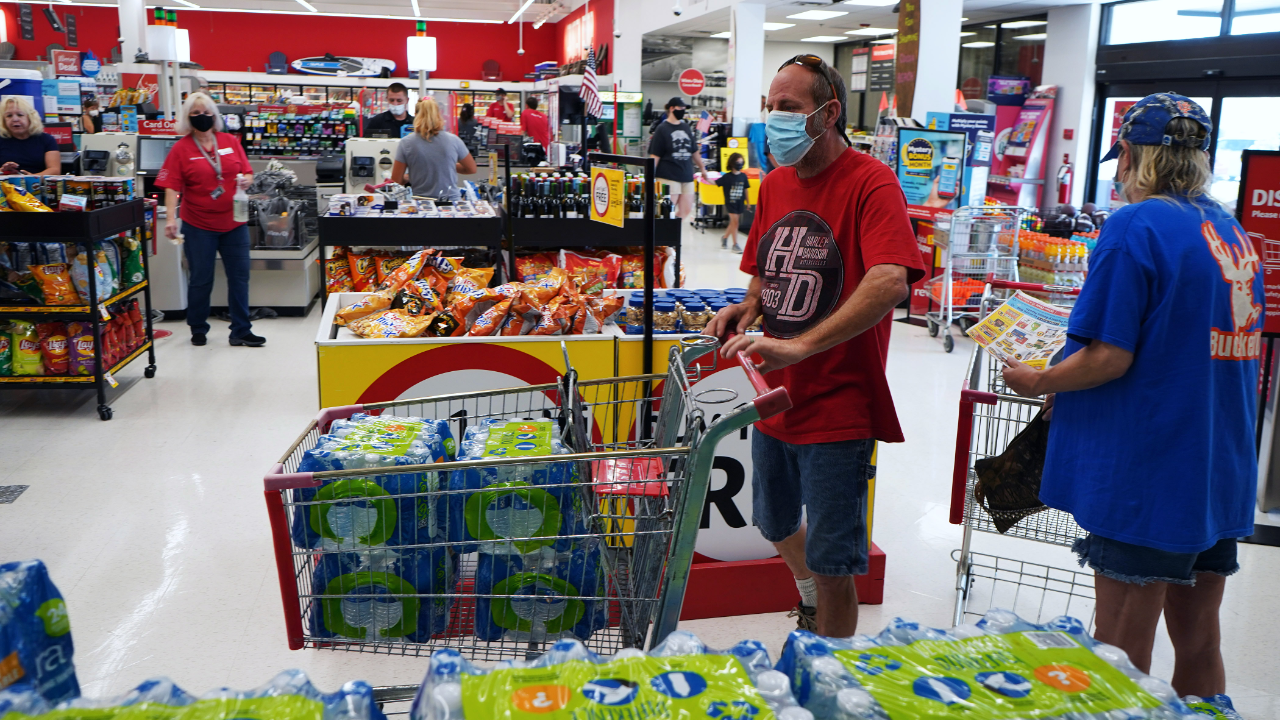Should you be worried about inflation? Here’s what the experts are saying

The Bankrate promise
At Bankrate we strive to help you make smarter financial decisions. While we adhere to strict , this post may contain references to products from our partners. Here's an explanation for .
Americans haven’t heard this one in a while: Inflation is back. Consumer prices soared 4.2 percent from a year ago, the largest burst in more than a decade. That comes as the U.S. economy stages a dramatic reopening from the devastating coronavirus shock, with mobs of consumers ready to spend again after being sheltered in their homes for more than a year.
Underpinning the recovery is massive federal spending and an ultra-accommodative Federal Reserve, which has pledged to keep rates at rock bottom until the financial system has fully weathered the storm.
Rapid price gains haven’t proven to be much of an economic threat for the past four decades, averaging out to about 2.5 percent annually since 1986. Yet, deep-rooted in Americans’ minds is a 15-year stretch beginning in the 1970s, when consumer prices soared as high as nearly 15 percent in the aftermath of big federal spending, two oil shocks and a slow-moving Fed. Economists now call it the Great Inflation, an ugly label both for policymakers and consumers alike.
But is what’s happening now a repeat of the past, and should you be worried about your money losing value? Experts are saying it’s not yet time to panic, though it’s wise to re-evaluate your finances for smart inflation hedges.
“Inflation is probably the single biggest threat that faces investors over the long run, and what makes it more insidious is, unless you’re reminded of it as we have been recently, it’s kind of like oxygen,” says Scott Clemons, chief investment strategist at Brown Brothers Harriman. “It’s just always there without you noticing it.”
What’s causing the recent uptick in inflation?
The Fed, which Congress has put in charge of controlling inflation, typically wants price pressures to average out to about 2 percent over time. For the past decade, officials have encountered the direct opposite problem: lukewarm inflation, below the Fed’s 2 percent target. Officials say longer-run economic changes from globalization, fewer unions and technological innovations have helped create powerful disinflationary pressures.
U.S. central bankers and economists don’t see those forces disappearing; rather, they see the recent price bursts as a temporary phenomenon, reflecting a perfect storm of events related to the coronavirus.
Assembly lines shut down and firms operated at reduced capacity for months after cutting nearly 15 percent of all jobs in the U.S. economy, reducing production and leading to shortages.
Yet, demand in some corners of the economy popped, thanks to now-vaccinated consumers’ readiness to start traveling, dining out and spending again. A prime example: Airline ticket prices are already up 10.2 percent between March and April of this year, Transportation Security Administration (TSA) check ins are more than three times higher than they were back in March, while some companies haven’t been able to bring up their flight crews to complete capacity (Delta, for example, canceled over 100 flights in April due to staffing shortages).
That’s creating what’s called a demand-pull inflation, one of two typical causes of inflation, that results in a shortage of products and services. Experts say it highlights how difficult it is to flip the economy’s switch to on, that a sharp plunge can’t always be followed by an equally as strong snapback.
“When you get that whipsaw, you get these supply shortages, aggravated by really strong demand, in a short period of time,” says Gary Schlossberg, global strategist for Wells Fargo Investment Institute (WFII). He uses housing as an example. “Everybody assumed housing would be on its back, a repeat of what we had 12 years ago. Lumber mills started by shutting down, and then certainly, we had housing demand grow back unexpectedly. Businesses have been racing to catch up ever since.”
Experts say other more practical forces could be at play. Congress has so far spent nearly $6 trillion on coronavirus relief measures and the money supply is at its largest ever, creating what some experts say could be too-ample liquidity chasing too few of goods, drawing on the views of Milton Friedman.
Even despite the worst unemployment crisis since the Great Depression, savings rates and personal income have soared, thanks to three coronavirus stimulus checks and ramped up unemployment benefits since the onset of the crisis.
“Supply chain bottlenecks — most folks acknowledge that’s probably temporary,” says Aaron Anderson, senior vice president of research at Fisher Investments. “What’s happening in the midst of all this is the money supply pick up. That’s the real inflationary force that’s out there.”
Meanwhile, a burst in year-over-year inflation was expected, simply because price pressures collapsed last year as the gears of commerce stopped turning.
Will the current inflation burst be temporary?
Most economists say these reopening challenges will abate at some point, with supply eventually balancing back out with demand, firms soon reaching full-capacity and Americans’ post-pandemic demand leveling off after a few months. The question, however, is how long temporary will last and whether those disinflationary forces will end up overpowering the reasons for the recent inflationary burst over time.
“When those two meet, who’s going to win?” says John Cunnison, CFA, chief investment officer at Baker Boyer Bank. “What the Fed is saying is, all this supply and demand will just solve itself and those disinflationary pressures we experienced last decade will reassert itself, and we’ll glide into 2 percent. That’s possible, and if that happens, it bodes really well for growth. But it’s also possible that one of them will overwhelm the other. If that’s the case, things could be a little rocky.”
The longer higher prices linger, the more likely they risk raising consumers and firms’ expectations that the price burst will be permanent, highlighting a psychological component to price increases that Fed officials have often said is a key area to watch.
When consumers start to expect higher inflation, they’re more likely to start making their big-ticket purchases now, with the idea that they’ll only get more expensive the longer they wait. That also gives them a bigger impetus to ask for higher pay. Both forces then prompt firms to start raising prices.
Data out there already suggests that’s starting to happen. One market gauge of investors’ expectations for prices soared the highest since 2006. Meanwhile, a closely watched survey of households’ opinions out of the University of Michigan soared by the most in seven years.
Fed officials see inflation expectations as the last line of defense between skyrocketing prices. But if those expectations start to get dislodged, the ultimate risk is that the U.S. central bank might have to abandon its patient interest rate approach. The fear that the Fed may perhaps have to hike interest rates too soon and halt the U.S. economic rebound in its tracks is leaving investors apprehensive. Another growing concern is that the Fed might not be acting soon enough.
“It begins to raise the risk that the Fed is behind the curve, that the Fed is asleep at the switch,” Clemons says.
Is higher inflation here to say? It’s too soon to tell
It’s too soon to tell, however, whether that’s happening. Experts point out that the Great Inflation took almost a decade in the making, with prices rising consistently for 10 years during the 1960s. The Fed wouldn’t worry about a one-time burst in prices, experts say. In fact, it would probably look kindly on the occurrence, considering inflation has remained so tepid over the past few decades. Companies, such as Chipotle and McDonald’s, are already raising wages to woo workers amid concerns of a labor shortage, but those build ups aren’t expected to be sustained.
“We do think it’s likely to be temporary, but that’s more on the four or five-quarter time frame when the longer term forces that have kept inflation down for so many years start to reassert themselves,” says Yung-Yu Ma, chief investment strategist for BMO Wealth Management. “We’ve been going through modest wage increases for a very long time now — for years, if not decades. We don’t think this is going to come undone over the course of a year or so.”
The caveat to the money supply piece is that a bulk of federal relief money was spent at helping households and firms survive the pandemic-induced lockdowns. Meanwhile, swaths of the economy are still struggling, offering their own disinflationary forces. Lower-income individuals are still experiencing elevated joblessness and bearing a bigger income hit, according to Federal Reserve surveys. They also show an increased likelihood to spend their federal relief money immediately on bills and essentials.
“Most of what’s happened here fiscally has been just trying to bridge the gap between the COVID lockdowns and reopenings,” Ma says. “They’re not really stimulative for the economy. All of the effects people think are going to be very inflationary are probably more muted than what we think they are.”
What should you do with your wallet?
Experts say consumers and investors should always be thinking about inflation and finding good hedges against rising prices. All of that means the prospect of higher prices shouldn’t change your approach all that much.
Stocks tend to be a decent inflation hedge because companies can pass along their price increases, offering a medium-term inflation hedge, Ma says. “But you really have to give more thought to which companies are going to have difficulty maintaining profit margins. The question ultimately is going to be which companies are able to pass on rising costs to the consumers. That’s going to be the ultimate differentiation in the marketplace.”
Experts recommend looking across your portfolio for income, including from dividend-paying stocks, preferred stocks and real estate investment trusts.
Another beneficial strategy can be incorporating inflation-indexed bonds, the most common being Treasury-Inflation Protected Securities (TIPS). TIPS protect you from inflation by design. They pay a fixed interest rate every six months and an inflation adjustment on a semiannual basis, which applies to the bond’s face value, rather than its yield.
At the same time, you generally want to avoid parking too much cash on the sidelines in fixed-income investments, such as government bonds. And with paranoia about higher inflation mounting, experts say it’s best to avoid panic buying. Emotions shouldn’t be behind any major financial decision.
While a bout of higher inflation might seem like the wrong time to prioritize saving, building up an emergency fund of six to nine months’ worth of your expenses is still a wise idea, considering that economic uncertainty rises along with inflation. But after that, higher inflationary environments are a particularly important time to make sure that you start searching for a better return — especially for consumers, who are losing purchasing power.
“Political power will ebb and wane, interest rates will rise and fall, different parties will control Congress, business cycles will come and go,” Clemons says. “But the one thing that is always going on in the background is that inflation is eating away at the purchasing power of your portfolio and wealth. That doesn’t matter this week or next week, but however long the time period is, inflation becomes that much more of a risk.”
Learn more:
Related Articles

Top high-yield savings accounts are now beating inflation. Here’s why that’s important

Survey: Has inflation peaked? Here’s what the nation’s top economists say

Worried about surging inflation? Here’s how to protect your wallet from taking a big hit
